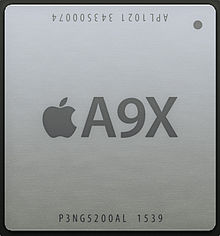Apple A9X
 Apple A9X chip | |
| General information | |
|---|---|
| Launched | September 9, 2015 |
| Discontinued | June 5, 2017 |
| Designed by | Apple Inc. |
| Common manufacturer | |
| Product code | APL1021 |
| Performance | |
| Max. CPU clock rate | 2.16 GHz[1] to 2.26 GHz[2] |
| Cache | |
| L1 cache | Per core: 64 KB instruction + 64 KB data |
| L2 cache | 3 MB shared |
| Architecture and classification | |
| Application | Mobile |
| Technology node | 16FF+ nm (TSMC)[3] |
| Microarchitecture | Twister[4][5] |
| Instruction set | ARMv8-A: A64, A32, T32 |
| Physical specifications | |
| Cores |
|
| GPU | Custom PowerVR Series7XT (12 cores)[3][6] |
| Products, models, variants | |
| Variant | |
| History | |
| Predecessor | Apple A8X |
| Successor | Apple A10X |
The Apple A9X is a 64-bit ARM architecture-based system on a chip (SoC) designed by Apple Inc., part of the Apple silicon series. It first appeared in the iPad Pro, which was announced on September 9, 2015 and was released on November 11, 2015.[7] The A9X has the M9 motion coprocessor embedded in it, something not seen in previous chip generations. It is a variant of the A9 and Apple claims that it has 80% more CPU performance and twice the GPU performance of its predecessor, the A8X.[8]
The latest software update for the iPad Pro 12.9 1st generation & 9.7 using this chip was iPadOS 16.7.9, released on July 29, 2024, as it was discontinued with the release of iPadOS 17 in 2023 due to hardware limitations of the A9X. It is expected to continue receiving security updates for some period of time.
Design
The A9X features an Apple-designed 64-bit ARMv8-A dual-core CPU called "Twister".[5] It offers double the memory bandwidth and double the storage performance of the Apple A8X.[9]
Unlike the A9, the A9X does not contain an L3 cache due to its significant DRAM bandwidth. The A9X is paired with 4 GB of LPDDR4 memory in the 12.9" iPad Pro and 2 GB of LPDDR4 memory in the 9.7" iPad Pro with a total bandwidth of 51.2 GB/s. This high bandwidth is necessary to feed the SoC's custom 12-core PowerVR Series7XT GPU.[10][6] The RAM is not included in the A9X package unlike its sibling, the A9.
The A9X uses the same NAND interface as the A9, which uses an Apple-designed NVMe-based controller that communicates over a PCIe connection.[11] The iPad Pro's NAND design is more akin to a PC-class SSD than embedded flash memory common on mobile devices. This gives the iPad Pro a significant storage performance advantage over competitors which often use mSATA or eMMC to connect to their storage systems.
The A9X has video codec encoding support for H.264. It has decoding support for HEVC,[12] H.264, MPEG‑4, and Motion JPEG.[13]
Products that include the Apple A9X
- iPad Pro 9.7-inch (2016)
- iPad Pro 12.9-inch (2015)
- Apple TV 4K (unreleased)[14]
See also
- Apple silicon, the range of ARM-based processors designed by Apple.
- Apple motion coprocessors
- Comparison of ARMv8-A cores
References
- ^ "9.7 inch iPad Pro includes 2 GB RAM, slightly slower CPU than 12.9 inch iPad Pro". 22 March 2016. Archived from the original on 2016-03-24. Retrieved 2016-03-24.
- ^ a b "The A9X SoC & More To Come - The iPad Pro Preview: Taking Notes With iPad Pro". AnandTech. November 11, 2015. Archived from the original on November 13, 2015. Retrieved November 11, 2015.
- ^ a b Smith, Ryan (November 30, 2015). "More on Apple's A9X SoC". AnandTech. Archived from the original on December 1, 2015. Retrieved November 30, 2015.
- ^ Joshua Ho. "iPhone 6s and iPhone 6s Plus Preliminary Results". anandtech.com. Archived from the original on 2016-05-26. Retrieved 2015-09-28.
- ^ a b Joshua Ho, Ryan Smith. "A9's CPU: Twister - The Apple iPhone 6s and iPhone 6s Plus Review". anandtech.com. Archived from the original on 2016-01-18. Retrieved 2015-11-03.
- ^ a b Kanter, David. "A Look Inside Apple's Custom GPU for the iPhone". Archived from the original on 2019-08-27. Retrieved 2019-08-27.
- ^ "Apple Introduces iPad Pro Featuring Epic 12.9-inch Retina Display" (Press release). Apple. September 9, 2015. Archived from the original on September 11, 2015. Retrieved September 9, 2015.
- ^ Chester, Brandon (September 9, 2015). "Apple Announces the iPad Pro and iPad Mini 4". AnandTech. Archived from the original on October 9, 2016. Retrieved September 9, 2015.
- ^ "Apple's new iPad Pro is an expansive 12.9 inches, available in November". Ars Technica. 9 September 2015. Archived from the original on 24 March 2017. Retrieved 9 September 2015.
- ^ "More on Apple's A9X SoC: 147mm2@TSMC, 12 GPU Cores, No L3 Cache". AnandTech. Archived from the original on 1 December 2015. Retrieved 30 November 2015.
- ^ "The Apple iPad Pro Review". Archived from the original on 24 January 2016. Retrieved 25 January 2016.
- ^ Thomson, Gavin. "Introducing HEIF and HEVC". Apple. pp. Slide 71 of presentation. Archived from the original on 27 December 2021. Retrieved 27 December 2021.
- ^ "iPad Pro (9.7-inch) - Technical Specifications". support.apple.com. Retrieved 2022-11-05.
- ^ "iPhone firmware leak suggests Apple considered A9X for Apple TV". AppleInsider. 2018-02-09. Retrieved 2024-06-23.
